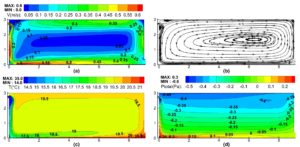
The air flow distribution characterizing conditioned indoor environments obtained following conventional design methodologies does not always guarantee both thermal comfort and indoor air quality (IAQ) for all occupants. This occurs because this air flow distribution depends on factors such as the air supply conditions, the grilles and diffusers position/size, and the environmental conditions. Accordingly, the aim of this work is to numerically study the influence of the air supply conditions and the positioning and size of air-conditioning system grilles on the thermal comfort and IAQ in indoor environments. For this purpose, an optimization scheme involving genetic algorithms and computational fluid dynamics techniques has been initially developed. Three objective functions have been next separately optimized, predicted mean vote—predicted percentage dissatisfied (PMV-PPD), percentage of dissatisfied due to draft (PD) and air change effectiveness (ACE). The optimal indoor environment configuration based on the PPD produces the best results in terms of thermal comfort (PPD = 6.6%, PD = 18.7%) indexes. This configuration also features the second lowest energy consumption (774 W). Furthermore, the configuration based on the ACE both presents PMV (≤ − 1.3) and PD (≥ 20%) values far from the acceptability criteria given by the standards, and involves the highest energy consumption (1832 W). Notice that the optimization of thermal comfort indexes implies indirectly optimizing the related systems energy demand as well. When using indexes such as PPD and PD as the optimization objective functions indeed, the total energy consumption is also reduced.
Autor(es):ANGELES, Luis
CELIS, Cesar
Año: 2021
Título de la revista: International Journal of Energy and Environmental Engineering
Volumen: 12
Página inicial - Página final: 787 - 804
Url: https://doi.org/10.1007/s40095-021-00412-1
